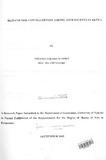| dc.contributor.author | Mwangi, Tabitha W | |
| dc.date.accessioned | 2013-05-10T06:23:08Z | |
| dc.date.available | 2013-05-10T06:23:08Z | |
| dc.date.issued | 2005-09 | |
| dc.identifier.uri | http://erepository.uonbi.ac.ke:8080/xmlui/handle/123456789/21047 | |
| dc.description.abstract | The government's efforts in the provision of family planning services have been successful in lowering
the countries fertility rate, however adolescents have generally been sidelined as a special category
group. This study has examined the determinants of contraceptive demand using data from KDHS
(2003) by employing binary and multinomial logit models. Individual and provider characteristics
display the expected signs with age, gender, educational attainment, socioeconomic status and frequency
of listening to the radio positively influencing the use of contraceptives while marital status and distance
having a negative influence. Choice of public facilities as sources of contraceptives is influenced by
individual's gender, marital status, fertility and access to information while private is only influenced by
gender. The education level of individuals has a negative influence on the choice of pharmacy as a
source but females use the facility more than males. The variables used could however not explain why
individuals use traditional methods (self-care) of family planning. | en |
| dc.description.sponsorship | University of Nairobi | en |
| dc.language.iso | en | en |
| dc.subject | Contraception | en |
| dc.subject | Adolescents | en |
| dc.subject | Kenya Demographic Health Survey (KDHS) | en |
| dc.subject | Multinomial logit models | en |
| dc.subject | Kenya | en |
| dc.title | Demand for Contraception Among Adolescents in Kenya | en |
| dc.type | Thesis | en |
| local.publisher | Department of Economics, University of Nairobi | en |

